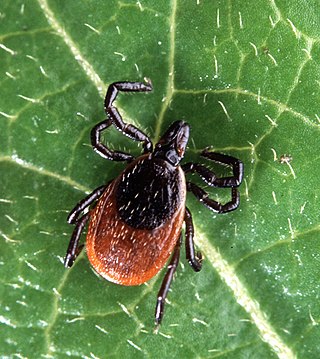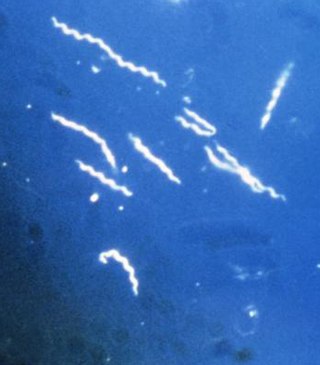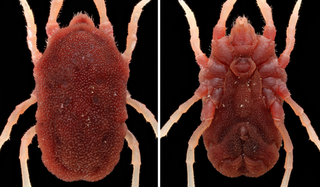
Ticks are parasitic arachnids of the order Ixodida. They are part of the mite superorder Parasitiformes. Adult ticks are approximately 3 to 5 mm in length depending on age, sex, species, and "fullness". Ticks are external parasites, living by feeding on the blood of mammals, birds, and sometimes reptiles and amphibians. The timing of the origin of ticks is uncertain, though the oldest known tick fossils are from the Cretaceous period, around 100 million years old. Ticks are widely distributed around the world, especially in warm, humid climates.

Lyme disease, also known as Lyme borreliosis, is a tick-borne disease caused by species of Borrelia bacteria, transmitted by blood-feeding ticks in the genus Ixodes. The most common sign of infection is an expanding red rash, known as erythema migrans (EM), which appears at the site of the tick bite about a week afterwards. The rash is typically neither itchy nor painful. Approximately 70–80% of infected people develop a rash. Early diagnosis can be difficult. Other early symptoms may include fever, headaches and tiredness. If untreated, symptoms may include loss of the ability to move one or both sides of the face, joint pains, severe headaches with neck stiffness or heart palpitations. Months to years later, repeated episodes of joint pain and swelling may occur. Occasionally, shooting pains or tingling in the arms and legs may develop. Despite appropriate treatment, about 10 to 20% of those affected develop joint pains, memory problems, and tiredness for at least six months.
Tick-borne diseases, which afflict humans and other animals, are caused by infectious agents transmitted by tick bites. They are caused by infection with a variety of pathogens, including rickettsia and other types of bacteria, viruses, and protozoa. The economic impact of tick-borne diseases is considered to be substantial in humans, and tick-borne diseases are estimated to affect ~80 % of cattle worldwide. Most of these pathogens require passage through vertebrate hosts as part of their life cycle. Tick-borne infections in humans, farm animals, and companion animals are primarily associated with wildlife animal reservoirs. Many tick-borne infections in humans involve a complex cycle between wildlife animal reservoirs and tick vectors. The survival and transmission of these tick-borne viruses are closely linked to their interactions with tick vectors and host cells. These viruses are classified into different families, including Asfarviridae, Reoviridae, Rhabdoviridae, Orthomyxoviridae, Bunyaviridae, and Flaviviridae.

Borrelia burgdorferi is a bacterial species of the spirochete class in the genus Borrelia, and is one of the causative agents of Lyme disease in humans. Along with a few similar genospecies, some of which also cause Lyme disease, it makes up the species complex of Borrelia burgdorferi sensu lato. The complex currently comprises 20 accepted and 3 proposed genospecies. B. burgdorferi sensu stricto exists in North America and Eurasia and until 2016 was the only known cause of Lyme disease in North America. Borrelia species are Gram-negative.
Relapsing fever is a vector-borne disease caused by infection with certain bacteria in the genus Borrelia, which is transmitted through the bites of lice, soft-bodied ticks, or hard-bodied ticks.

Borrelia is a genus of bacteria of the spirochete phylum. Several species cause Lyme disease, also called Lyme borreliosis, a zoonotic, vector-borne disease transmitted by ticks. Other species of Borrelia cause relapsing fever, and are transmitted by ticks or lice, depending on the species of bacteria. A few Borrelia species as Candidatus Borrelia mahuryensis harbor intermediate genetic features between Lyme disease and relapsing fever Borrelia. The genus is named after French biologist Amédée Borrel (1867–1936), who first documented the distinction between a species of Borrelia, B. anserina, and the other known type of spirochete at the time, Treponema pallidum. This bacterium must be viewed using dark-field microscopy, which make the cells appear white against a dark background. Borrelia species are grown in Barbour-Stoenner-Kelly medium. Of 52 known species of Borrelia, 20 are members of the Lyme disease group, 29 belong to the relapsing fever group, and two are members of a genetically distinct third group typically found in reptiles. A proposal has been made to split the Lyme disease group based on genetic diversity and move them to their own genus, Borelliella, but this change is not widely accepted. This bacterium uses hard and soft ticks and lice as vectors. Testing for the presence of the bacteria in a human includes two-tiered serological testing, including immunoassays and immunoblotting.

Wilhelm Burgdorfer was a Swiss-American scientist and an international leader in the field of medical entomology. He discovered the bacterial pathogen that causes Lyme disease, a spirochete named Borrelia burgdorferi in his honor.

Lyme disease, or borreliosis, is caused by spirochetal bacteria from the genus Borrelia, which has 52 known species. Three main species are the main causative agents of the disease in humans, while a number of others have been implicated as possibly pathogenic. Borrelia species in the species complex known to cause Lyme disease are collectively called Borrelia burgdorferisensu lato (s.l.) not to be confused with the single species in that complex Borrelia burgdorferi sensu stricto which is responsible for nearly all cases of Lyme disease in North America.

Borrelia hermsii is a spirochete bacterium representing the endemic causative agent of tick-borne relapsing fever in eastern regions of North America. It is spread by the soft-bodied tick Ornithodoros hermsi. Human infections characteristically occur among campers and people temporarily lodging in wooden accommodations in proximity to rodents. Human disease is usually relatively mild with low fever.
Borrelia afzelii is a species of Borrelia endemic to parts of Eurasia where it is one of the causative agents of Lyme disease. It is transmitted by hard-bodied ticks of the Ixodes genus, infecting various wild mammals in nature.
Carios erraticus, formerly called Ornithodoros erraticus, is a species of tick in the family Argasidae. The tick was described by Hippolyte Lucas in 1849.

Ornithodoros is a genus in the soft-bodied tick family, Argasidae.

Ornithodoros hermsi is a species of soft tick. It can be infected with Borrelia hermsii.

Ornithodoros moubata, commonly known as the African hut tampan or the eyeless tampan, is a species of tick in the family Argasidae. It is an ectoparasite and vector of relapsing fever in humans, and African swine fever in pigs.

Ornithodoros turicata, commonly referred to as the relapsing fever tick, is a soft tick found in the midwestern and southwestern United States. It is a known vector of Borrelia turicatae, a spirochete responsible for tick-borne relapsing fever in humans. Additionally, vector competence for the transmission of Leptospira pomona, the agent of canine jaundice, has been demonstrated in a laboratory setting.
Borrelia miyamotoi is a bacterium of the spirochete phylum in the genus Borrelia. A zoonotic organism, B. miyamotoi can infect humans through the bite of several species of hard-shell Ixodes ticks, the same kind of ticks that spread B. burgdorferi, the causative bacterium of Lyme disease. Ixodes ticks are also the primary vector in the spread of babesiosis and anaplasmosis.

Joseph Everett Dutton was a British parasitologist who discovered one of the trypanosomes that cause sleeping sickness. He died in the Congo Free State at the age of 30 from tick fever, or African relapsing fever, while investigating the disease, which is caused by a spirillum that was later named Borrelia duttoni.
Borrelia turicatae is a bacterial species of the spirochaete class of the genus Borrelia. It is one of the relapsing fever spirochaetes, which are globally distributed yet understudied agents of tick-borne relapsing fever. The tick vector Ornithodoros turicata transmits B. turicatae, which causes relapsing fever, an arthropod-borne infection of humans and other mammals caused by different Borrelia species. B. turicatae is long and spiral-shaped, as is typical for all spirochaetes. It is a Gram-negative bacterium and visible with light microscopy. Few epidemiological studies have been performed and few molecular data exist for B. turicatae and its arthropod vector O. turicata.
Borrelia coriaceae is a species of spirochete bacteria and member of the genus Borrelia. Strains of this species have been isolated from the soft tick Ornithodoros coriaceus and from mule deer.

Ornithodoros savignyi, known as sand tampan, African eyed tampan or Kalahari sand tampan, is one of some 37 species in the genus Ornithodoros and is a soft tick with a leathery, mammillated integument, causing paralysis and tampan toxicosis, two unrelated conditions. The sand tampan is an ectoparasite on humans, their livestock and wild animals, including birds and bats. Occurring in semi-desert areas of Africa, Saudi Arabia and other parts of the Persian Gulf, India, Sri Lanka and into Asia, it is able to survive for lengthy periods without feeding, spending most of its life burrowed under sand or loose soil, often in wait for animals that rest or sleep under trees or in the lee of rocks, but also in places where people or their animals congregate such as marketplaces, places of worship, cattle kraals and village squares. The timing of its activity is geared to coincide with that of potential hosts, but hot sunny conditions are usually avoided. Because of its habit of feeding and dropping from its host, adult dispersal is limited, whereas larvae may remain attached to their hosts for several days. During its life cycle it will feed on multiple hosts between moults.










